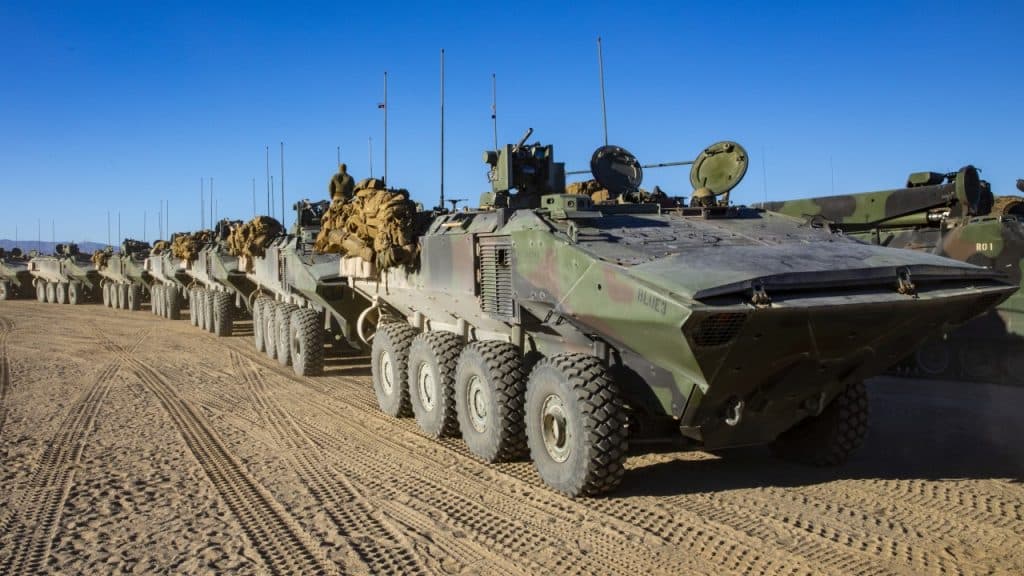It can be said that the new amphibious ACV armored personnel carriers turned out to be salt in the eye for the US Marine Corps. USNI News said the Marines were suspending the first operational assignment of ACV carriers, which was due to begin later this year. The vehicles were to be delivered to subunits of the 13th Marine Expeditionary Unit (MEU) and the Makin Island Rapid Reaction Assault Group (ARG).
The reason for the delay? Ongoing investigation following an incident in July this year in which the propulsion system malfunctioned in two transporters during tests in the ocean. In addition, the Corps is not able to accept the vehicles, as the logistic chain for ACV operation has not yet been developed and the certification process of the new type of weapon has not yet been completed.
ACV leaving the dock of the landing ship USS Somerset (LPD 25).
(US Marine Corps / Lance Cpl. Drake Nickels)
The new transporters were to be embarked on three vessels that make up ARG Makin Island: the USS Makin Island (LHD 8), which lends her name to Wasp, and a pair of San Antonio, USS John P. Murtha (LPD 26) and USS Anchorage (LPD 23). These units are certified to carry ACV on landing decks. Makin Island ARG together with the 13th MEU was to be the first tactical union of the marines to be equipped with a new generation transporter. For two years, however, the marines have been struggling with numerous problems in the fleet of their amphibians.
It goes without saying that the Corps is a landing force, at least in its assumption. At present, however, he cannot use his new floating landing gear by sea – at least until the investigation has been completed and the operational and training procedures for ACV have been developed.
USS Makin Island (LHD 8) leaves San Diego.
(Senior Chief Mass Communication Specialist Donnie W. Ryan, US Navy)
The streak of misfortunes surrounding the Corps’ floating carriers began in July 2020, when a tragic accident involving the aged AAV7 occurred during maneuvers off the California coast. The transporter sank during an exercise simulating an amphibious assault. Eight marines and a US Navy sailor were killed then. After the investigation, numerous irregularities related to the improper operation and servicing of the AAV7 and the training of the crews came to light. Also, the technical condition of some of the transporters was bad and posed a threat to the safety of the crews. Since the accident, it is forbidden to use these amphibians for landing exercises by sea.
The new ACVs are also not free from defects and problems. Since July this year, after the incident mentioned at the beginning, they cannot be used for exercises in the water. In two transporters, during the high wave, there was a failure of the drive system and thus a power loss. This time no one was hurt.
The first batch of eighteen vehicles was delivered to the USMC in October 2020. The Corps will acquire at least 704 examples in several variants: armored personnel carrier (ACV ‑ P), command vehicle (ACV ‑ C), with a 30 millimeter automatic cannon (ACV ‑ 30) and technical protection (ACV ‑ R). The new car is to replace the outdated AAV7 armored personnel carriers, which have been in service with the Corps since 1972.
Currently, the USMC is undergoing major structural changes related to a complete redefinition of the use of formation in the Indo-Pacific region. Among other things, the armored units of the Corps are being liquidated. This decision was not a result of the conviction that tanks would be declining usefulness in the modern battlefield, but of operational assumptions for the Indo-Pacific region. According to the presented concept of Force Design 2030, the marines are to return to their roots, i.e. become a landing force again, and not a heavy mechanized formation for operations in the hinterland. The USMC acquired this character during its operations in Afghanistan and Iraq.
ACV on the beach at Camp Pendleton. USS Makin Island in the distance.
(US Navy / Mass Communication Specialist 2nd Class Kristopher S. Haley)
Thus, the emphasis is on equipping the Corps with vehicles that provide basic protection and high mobility, while at the same time being less burden on logistics. Getting rid of the Tank Corps structures is to be compensated by the US Army if there is a need for tank support and the conditions are favorable for their use. This movement may be a kind of tribute to the ground forces that are trying to find a place in the concepts of the war in the Pacific. According to the new concept, the USMC is to operate in small, highly mobile and autonomous troops, focused – in addition to capturing or defending islands considered key – also to counter air and sea targets in order to provide the US Navy with greater freedom in operations.
Landing operations, including the use of amphibious APCs, are a fundamental element of the Marine Corps’ operations and are critical to the ability to remain a major US expeditionary force on standby, Lieutenant General David Furness said earlier this year. Currently, these words can bring a slight smile to your face, as the structure designed mainly for sea landing cannot fully perform the tasks for which it was created.
See also: FDI agreement signed for Greece
US Marine Corps / Sgt. Courtney G. White

